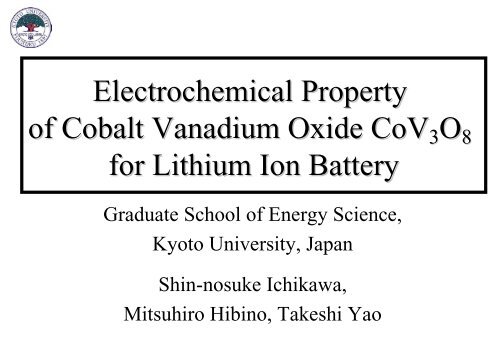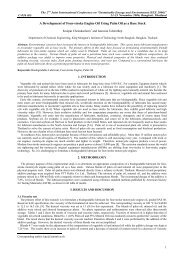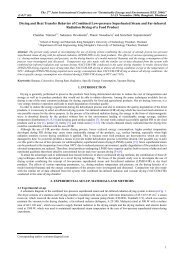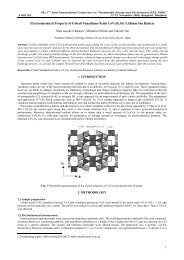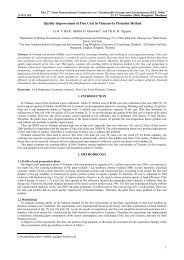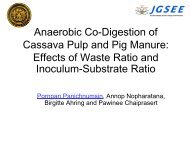Electrochemical Property of Cobalt Vanadium Oxide CoV3O8 for ...
Electrochemical Property of Cobalt Vanadium Oxide CoV3O8 for ...
Electrochemical Property of Cobalt Vanadium Oxide CoV3O8 for ...
Create successful ePaper yourself
Turn your PDF publications into a flip-book with our unique Google optimized e-Paper software.
<strong>Electrochemical</strong> <strong>Property</strong><br />
<strong>of</strong> <strong>Cobalt</strong> <strong>Vanadium</strong> <strong>Oxide</strong> CoV 3 O 8<br />
<strong>for</strong> Lithium Ion Battery<br />
Graduate School <strong>of</strong> Energy Science,<br />
Kyoto University, Japan<br />
Shin-nosuke Ichikawa,<br />
Mitsuhiro Hibino, Takeshi Yao
Introduction<br />
Transition metal oxides have been extensively studied in terms <strong>of</strong> electrode<br />
materials <strong>for</strong> lithium ion batteries.<br />
<strong>Vanadium</strong> oxides are one <strong>of</strong> the most promising materials due to<br />
availability, low toxicity, and low cost.<br />
<strong>Vanadium</strong> oxides are liable to collapse structurally by repetitions <strong>of</strong><br />
discharge and charge, leading to capacity fade.<br />
With a view to improve such poor cycle ability, variety <strong>of</strong> vanadium<br />
oxides have been prepared, <strong>for</strong> example, amorphous vanadium pentoxide<br />
V 2 O 5 , and vanadium based complex oxides, LiV 3 O 8 , NiO-V 2 O 5 , TiO-V 2 O 5<br />
etc.<br />
In this study,<br />
we investigate one <strong>of</strong> vanadium oxides CoV 3 O 8<br />
toward development <strong>of</strong> novel electrode materials <strong>for</strong> lithium ion batteries.
Previous knowledge <strong>of</strong> CoV 3 O 8<br />
CoV 3 O 8 has been synthesized by hydrothermal method <strong>for</strong> the first time,<br />
and its single crystal structure has been analyzed by Oka and Yao[1].<br />
CoV 3 O 8 has tunnel space along the c axis in the crystal structure and is<br />
expected to have good electrochemical per<strong>for</strong>mance.<br />
VO 4 Tetrahedron<br />
VO 5 Bipyramid<br />
MO 6 (M=Co,V) Octahedron<br />
b<br />
a<br />
Fig. Polyhedral representation <strong>of</strong> the crystal<br />
structure <strong>of</strong> CoV 3 O 8 projected onto ab plane.<br />
[1] Y. Oka, T. Yao, N. Yamamoto and Y. Ueda,<br />
J. Solid State Chem., 141, 133-139(1998).
Aim <strong>of</strong> this study<br />
Aim <strong>of</strong> this study is to develop cobalt vanadium oxide CoV 3 O 8 into an<br />
electrode material <strong>for</strong> lithium ion battery.<br />
In order to investigate the electrochemical property <strong>of</strong> CoV 3 O 8 , we need<br />
enough amount <strong>of</strong> this sample.<br />
But, if CoV 3 O 8 is synthesized by hydrothermal method, we can obtain only<br />
a small amount <strong>of</strong> the product.<br />
In this study<br />
CoV 3 O 8 is synthesized by solid-state reaction in order to prepare enough<br />
amount, and examined as an electrode material <strong>for</strong> lithium ion battery.
Method : Preparation and structural analysis<br />
Preparation and structural analysis <strong>of</strong> CoV 3 O 8<br />
CoO V 2 O 4<br />
V 2 O 5<br />
• mixed in the molar ratio <strong>of</strong> Co:V:O = 1:3:8<br />
• pressed cold-isostatically into a pellet<br />
• sealed in a silica tube<br />
• heat-treated at 600 o C <strong>for</strong> three days<br />
CoV 3 O 8<br />
• Powder X-ray diffraction pattern was taken.<br />
• The crystal structure was analyzed<br />
by the Rietveld method.
Method : <strong>Electrochemical</strong> measurement<br />
<strong>Electrochemical</strong> measurement <strong>of</strong> CoV 3 O 8<br />
Three electrode cell<br />
Working electrode : active material, acetylene black, poly(tetrafluoroethylene)<br />
in the weight ratio 80:15:5<br />
Counter electrode : lithium metal<br />
Reference electrode : lithium metal<br />
Electrolyte : 1 mol dm -3 LiClO 4 in Ethylene carbonate and<br />
1,2-Dimethoxyethane (1:1 v/v%)<br />
Cyclic voltammetry<br />
Potential : between 1.5 and 4.0V<br />
vs. Li + /Li<br />
Scan rate : 0.1mV s -1<br />
Discharge-charge cycle test<br />
Potential : between 1.5 and 4.0V<br />
vs. Li + /Li<br />
Current density : 80mA g -1
Method : Structural analysis<br />
Investigation <strong>of</strong> structural change <strong>of</strong> CoV 3 O 8<br />
induced by repetitions <strong>of</strong> discharge and charge<br />
The electrode material after 21st discharge<br />
• detached from the electrochemical cell<br />
• placed on a zero background plate <strong>of</strong> quartz<br />
• set in a sealed holder in a argon gas system<br />
Powder X-ray diffraction pattern was taken.
Result : X-ray diffraction and the Rietveld method<br />
CoV 3 O 8 obtained by solid-state reaction<br />
CoV 3 O 8 obtained by hydrothermal method<br />
Same crystal structure<br />
Intensity / count<br />
15000<br />
10000<br />
5000<br />
R wp = 0.091<br />
R B = 0.049<br />
R F = 0.028<br />
GOF = 2.77<br />
Δ<br />
0<br />
2500<br />
0<br />
-2500<br />
10 20 30 40 50 60<br />
2θ -MoKα / o<br />
Fig. Rietveld result <strong>for</strong> CoV 3 O 8 .<br />
935 reflections<br />
The calculated XRD pattern<br />
agreed with<br />
the observed XRD pattern
Result : Cyclic voltammetry<br />
Current density / mA g -1<br />
80<br />
40<br />
0<br />
-40<br />
-80<br />
-120<br />
-160<br />
1.95V<br />
2.1V<br />
around 2.7V<br />
2.4V<br />
0.1mV / s<br />
1st cycle<br />
2nd cycle<br />
1.6 2.0 2.4 2.8 3.2 3.6 4.0<br />
Potential vs. Li + /Li / V<br />
Fig. Cyclic voltammogram <strong>of</strong> CoV 3 O 8 .<br />
0.72<br />
0.36<br />
0.00<br />
-0.36<br />
-0.72<br />
-1.08<br />
-1.43<br />
Current / mA
Result : Discharge-charge cycle test<br />
Potential vs. Li + /Li / V<br />
4.0<br />
3.6<br />
3.2<br />
2.8<br />
2.4<br />
2.0<br />
1.6<br />
20<br />
1 2<br />
2.4V<br />
2.1V<br />
1.95V<br />
Around 2.7V<br />
0 20 40 60 80 100 120<br />
Specific capacity/mAh g -1<br />
Fig. Discharge-charge curves <strong>of</strong> CoV 3 O 8 .
Result : Discharge-charge cycle test<br />
Potential vs. Li + /Li / V<br />
4.0<br />
3.6<br />
3.2<br />
2.8<br />
2.4<br />
1<br />
2<br />
20<br />
Specific capacity / mAh g -1<br />
0 50<br />
2.0<br />
20 Good cycle per<strong>for</strong>mance<br />
1.6<br />
0 20 40 60 80 100 120<br />
0<br />
10 20 30 40<br />
Specific capacity/mAh g -1 Cycle<br />
Fig. Discharge-charge curves <strong>of</strong> CoV 3<br />
O 8<br />
. Fig. Discharge and charge capacities <strong>of</strong> CoV 3<br />
O 8<br />
.<br />
120<br />
100<br />
80<br />
60<br />
40<br />
discharge<br />
charge<br />
Lithium reacted electrochemically<br />
with CoV 3 O 8 reversibly.<br />
After the 2nd cycle, coulomb<br />
efficiency was almost unity.
Result : XRD pattern<br />
• No peak angles <strong>of</strong> CoV 3 O 8<br />
changed.<br />
• The intensity <strong>of</strong> the peaks<br />
<strong>of</strong> CoV 3 O 8 declined.<br />
• Unidentified peaks appeared.<br />
Fig. XRD pr<strong>of</strong>iles <strong>of</strong> the electrode material after 21st discharge<br />
and the initial CoV 3 O 8 as a reference.<br />
Lithium<br />
inserted
Interpretation<br />
Potential vs. Li + /Li / V<br />
4.0<br />
3.6<br />
3.2<br />
2.8<br />
2.4<br />
2.0<br />
1<br />
2<br />
20<br />
Large slope<br />
1.6<br />
0 20 40 60 80 100 120<br />
Specific capacity/mAh g -1<br />
This behavior implies<br />
• Amorphous phase is generated during the first discharge process.<br />
• Lithium is inserted into and extracted from the newly generated<br />
amorphous phase after the second cycle.
Interpretation<br />
Intensity (a.u.)<br />
Fig. XRD pr<strong>of</strong>iles <strong>of</strong> the electrode material after<br />
21st discharge and the initial CoV 3 O 8 as a reference.<br />
The intensity <strong>of</strong> the peaks decreased.<br />
Fig. XRD pr<strong>of</strong>ile <strong>of</strong> the electrode<br />
material after 21st discharge.<br />
The halo appeared around 30 o<br />
The generation <strong>of</strong> amorphous phase<br />
Good reversibility
Summary<br />
CoV 3<br />
O 8<br />
, which has tunnel space along the c axis in the crystal structure,<br />
was synthesized by solid-state reaction.<br />
Both electrochemical measurements and XRD indicated the following.<br />
For the first lithium insertion into CoV 3<br />
O 8<br />
, the crystal phase <strong>of</strong> CoV 3<br />
O 8<br />
was changed into amorphous phase.<br />
The amorphous phase is allowed to discharge and charge reversibly<br />
after the second cycle.<br />
The good cycle per<strong>for</strong>mance <strong>of</strong> CoV 3<br />
O 8<br />
may be caused by lithium<br />
insertion into and extraction from the generated amorphous phase.<br />
We concluded that<br />
CoV 3<br />
O 8<br />
is promising <strong>for</strong> an electrode material <strong>of</strong> lithium ion battery.
XRD pr<strong>of</strong>ile <strong>of</strong> zero background plate <strong>of</strong> quartz<br />
500<br />
Intensity / count<br />
400<br />
300<br />
200<br />
Zero background plate <strong>of</strong> quartz<br />
100<br />
0<br />
10 20 30 40 50 60 70 80 90<br />
2θ-CuKα / o<br />
Fig. XRD pr<strong>of</strong>ile <strong>of</strong> zero background plate <strong>of</strong> quartz
XRD pr<strong>of</strong>iles : Amorphous phase<br />
Initial CoV 3 O 8<br />
Electrode material after 21st discharge<br />
Intensity (a.u.)<br />
10 20 30 40 50 60 70 80 90<br />
2θ-CuKα / o
XRD pr<strong>of</strong>iles : Intensity <strong>of</strong> the peaks <strong>of</strong> CoV 3 O 8<br />
Initial CoV 3<br />
O 8<br />
Electrode material after 21st discharge<br />
Intensity (a.u.)<br />
10 20 30 40 50 60 70<br />
2θ-CuKα


